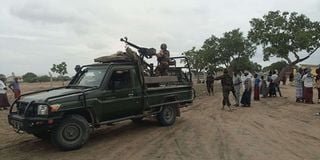Premium
Why Al-Shabaab operations thrive despite the pandemic

KDF soldiers patrolling the streets of Kotile town on the Garissa-Lamu-Somalia border.
What you need to know:
- Al-Shabaab is affiliated with a number of news websites that produce “independent news”.
- Al-Shabaab hosts its online content in a number of drives with Kataib Drive being central to its online ecosystem.
The advent of Covid-19 pandemic early this year brought the physical world to standstill. The containment measures called for cessation of movements, banning of in-person meetings, gatherings, closure of institutions of learning and places of worship.
This ushered in the “working-from-home” concept that was made possible by unprecedented uptick of internet.
This created an “online” community and led to fears that terrorist groups like Al-Shabaab would exploit the online naiveties to radicalise and recruit.
Although there is no corresponding empirical evidence to suggest that indeed Al-Shabaab has seized the situation, including vulnerabilities that were heightened by the containment measures; there is an overwhelming evidence that Al-Shabaab has doubled its online ecosystem.
Over a five-month period (June-October), researchers at the London based Institute for Strategic Dialogue (ISD) monitored, tracked, and analysed the content and linkages between standalone websites, social media platforms, and messaging applications exploited by Al-Shabaab.
The researchers honed in on content and accounts focused on Kenya, and the narratives in a range of languages, including Arabic, Somali and Swahili.
This analysis established that Al-Shaabab manages an extensive and somewhat complex digital propaganda network. This propaganda machine extends across social media and messaging platforms such as Facebook, Twitter, YouTube, WhatsApp, and Telegram.
Al-Shabaab is similarly affiliated with a number of news websites that produce “independent news” - giving gullible followers a false sense that they are legitimate news sources that function as central repositories for official content. These are further supported by Al-Qaeda websites that provide the backbone and support for Al-Shabaab content.
Ability to manipulate
As of September 2020, the study found out that Al-Shabaab were involved in 42 attacks on Kenyan soil, targeting civilians, the Defence Forces, and other security services. This was a considerable jump over 2019, in which Al-Shabaab was involved in 27 attacks the entire year.
That came out clearly is that Al-Shabaab operational capacity is not only expanding, but unhindered by the global pandemic.
It’s ability to manipulate and use social media platforms and the open web to spread its central narratives is similarly unhindered, and unchecked.
Al-Shabaab hosts its online content in a number of drives with Kataib Drive (named after the Al Shabaab outlet) that is hosted on a Montenegro country domain, being central to its online ecosystem.
The site received 100 per cent of its traffic from Kenya between March and May. Roughly 2,000 visitors with Kenya IPs accessed the site up until April when the traffic began to dip based on disruption in hosting.
In addition, the ISD researchers have been monitoring 20 Al-Shabaab affiliated Facebook pages. Using a sample of 8,000 followers, and their self-determined location data that pinpointed what countries the followers claimed to be from.
Outside of Somalia with the largest base of some 423 followers, the second largest in Africa was Kenya (33), followed by South Africa (15) and Ethiopia (13). In Kenya, the largest share of followers claimed to be in Nairobi, followed by Mombasa and Garissa.
In its digital space and propaganda machine, ISD researchers tracked the Kenya-based narratives that can be broadly classified into three categories that support local grievances.
One, corruption and its correlation to the democracies functioning as “client states” in the region, selling out its citizens and coming into direct conflict with shariah law.
Two, security (police and military) overreach, an extension of “the imperial visions” of states like the United States, UK, and European countries.
Three, subjugation of Muslims, whether through the politics of regional countries, or direct confrontation with security services and military. These narratives can be countered by the government and civil society (including Muslim clerics).




